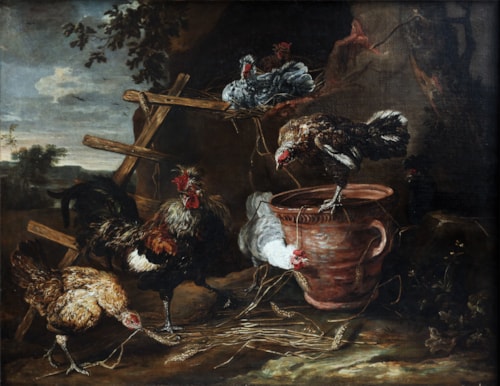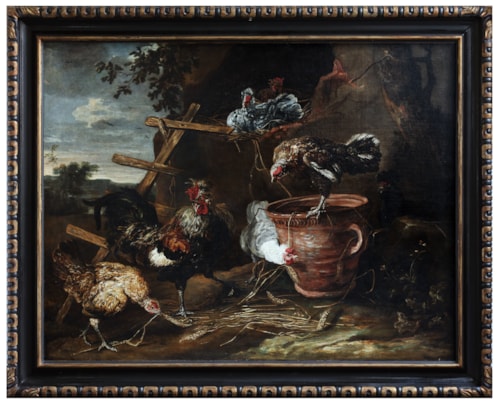Jan Fyt
(Antwerp 1611 - Antwerp 1661 )
The Rooster and the Jewel
Besides Frans Snyders and Paul De Vos, Jan Fyt was the most important Flemish animal painter of the 17th century. The painter came from a family from Sint-Niklaas and became a member of the Antwerp Sint-Luke Guild in 1630. After a long stay in Italy (Fyt was chairman of the "Bentvueghels" in Rome) and a stop in Paris, Fyt returned around 1641 to Antwerp where he ran a successful studio (his most famous student was Peter Boel). The influence of Jan Fyt's style on later painting was important; not only in the Netherlands (cfr David De Koninck) but also in Italy he would be of great importance for the still life-genre (the school around Guissepe Recco in particular).
Fyt is best known for his representations of dead game. He also painted live animals: hunting scenes with dogs or falcons, bird concerts an fighting animals were some of his favorite subjects.
We know of only another four paintings by Fyt representing chickens. Three of these canvasses have more or less the same dimensions as our painting. Two of them are in the Fine Arts Museum in Brussels and the other one at the Wallraf-Richartz Museum in Cologne. The fourth painting bij Jan Fyt representing chickens is the most interesting one, as it is very similiar to our painting (Prado Museum in Madrid). It is a larger composition, painted on a much larger canvas. It is unsigned, but dated 1660, so dating from one year before the artist's dead.
Concerning the subject of our work, Thomas Balfe wrote an interesting artice in the "Journal of Historians of Nederlandish art" (Winter 2021). Regarding our painting (mentioned in the article), Balfe writes: "A closer look at the painting reveals an important detail that broadens the interpretative response it demands. This is the jeweled ring beneath the cock’s leading foot (fig. 4), which signals an allusion to the Aesopic fable called The Cock and the Jewel.26 Upon finding a jewel (when named, usually a diamond, ruby, pearl, or a ring) while pecking in his straw for food, the cock declares that although it would be of great value to some people, it is of no use to him; he would prefer grains of corn or barley to eat. In the fable book tradition, this simple narrative is often interpreted as a condemnation of ignorance or materialism, failings embodied by the cock, who chooses transient bodily sustenance over the jewel, an object of lasting value.27 Unlike grain, however, a jewel cannot sustain life. Accordingly, alternative readings of the fable existed in which the pragmatism of the cock in preferring something useful over something showy, or his acuteness in noticing the jewel, are praised instead of censured. The Cock and the Jewel was evidently a popular fable in the Netherlands and may even have entered common language as a figure of speech, given its appearance in the 1603 Dutch translation of a conversation manual, where it demonstrates the differences between ignorant and learned people"
Published in "The journal of historians of Netherlandish art", Volume 13, Issue 1 (Winter 2021)
Oil on Canvas, 119 x 152 cm (46 ⁷/₈ x 59 ⁷/₈ inches)
Signed left below Jan Fyt fecit
+32 (0)478 38 18 29




